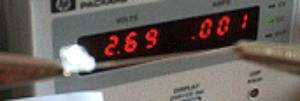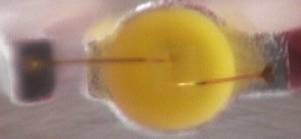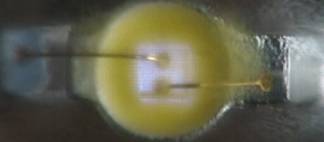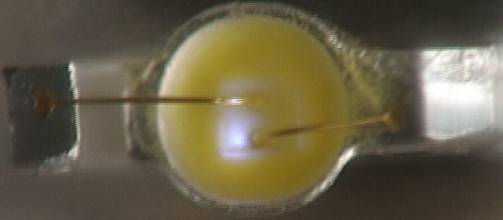
Applications
Engineering Notes
![]()
Failure Mode Analysis (FMA) Report on ESD Damaged White
LEDs
Background:
On April 2003, one of our customers
reported that they had experienced over 100 failures in their recently
received first batch of 100K white LED lamps. The customer reported that the
white LED lamps had instantaneously flashed ON after being connected
together during product assembly and then did not work anymore
thereafter. Immediately it was suspected that Electro Static Discharge (ESD)
damage was causing such failures. As measures were put in place in
their production facility to reduce all possible sources of ESD damage
(proper grounding of all equipment and personnel), a dramatic drop in
the failure rate/quantity while running production was experienced
(from over 166 pieces per 18,000 to 1 per 900).
Brite-LED received 166 �bad� LEDs,
which were sent by the customer for test and evaluation to confirm and
determine the actual cause(s) of their failure and thus the reason for
this report.
Evaluation
and Testing:
1.
Each of the 166 LEDs were tested individually with an HP Lab
Bench DC Power supply, by supplying a varying current. All of the LEDs
came ON. However, this happened at different forward current (IF)
levels.
2.
A few came on at or around just 1mA, a large group came ON
at around 15mA, other group came ON only after the applied forward
current reached 50mA, and a few came ON after the applied forward
current reached 150mA.
3.
On the LEDs that required the very high currents to turn ON,
the forward voltage increased very slowly at first as the applied
forward current was increased, but once they reached the turn ON
point, the current suddenly dropped and the voltage settled to the
corresponding expected VF levels.
4.
Once all the LEDs that required very high currents to turn
ON got �Started�, they came ON in subsequent trials at much lower
currents (8mA to 15mA). As if they got �semi-fixed�.
5.
A randomly picked group of 30 LEDs was inspected under a
microscope to look for any evidence of bond wire or die damage. None
was found. The wire bonds were intact. This finding revealed good
quality LED packaging given that the customer had bent outwardly the
leads of all LEDs extremely close (<1mm)
to the lower side of the epoxy lens, which could have caused
wire bond breakage.

Fig 1. Some LEDs come ON at IF=1mA
6.
A forward current was slowly applied to
some LEDs while the die was closely observed to find the turn ON point
and how the die behaved. It was found that in the LEDs with a high
current turn ON point, only half or a quarter of the die would come ON
at first. (See attached picture sequence below).
Close-up Pictures of LED that came ON at 1mA


Fig 2. LED is OFF (No current applied) Fig 3. LED just starts to turn ON (IF≈0.7mA; VF=2.47V)
Close-up
picture of a more severely damaged LED that comes ON at 29mA

Fig 4. Only a corner of the LED die comes ON at first. (IF=29mA; VF=2.42V).
8.
Another LED, similar to the one in figure 4, did not
initially come ON until a 170mA forward current was applied (@ VF=3.48V),
then suddenly the VF dropped to 2.71V and the forward
current dropped to 16mA. After that, the LED came ON at 15mA on
subsequent trials.
Conclusions
of Findings:
1.
As initially suspected, Electro Static Discharge (ESD)
caused the damage to the LEDs.
2.
This conclusion is based on the all of the compounded clear
evidence and behavior of the LEDs.
3.
ESD damage can range from catastrophic failure to various
degrees of non-so-evident damage.
4.
ESD damage to an electronic device, such as an LED, may lead
to intermittent behavior or premature device failure.
5.
ESD damaged devices can appear dim, dead, shorted, or with
low VF or VR All of the devices
tested show one or all of these symptoms
6.
Light
Emitting Diodes are static sensitive devices. InGaN on Sapphire die
(used in these white LEDs) is generally considered and thus rated as
an ESD Class 1 device (can survive 20V bias with Machine Model
Testing, and 130V from Human Body Model Testing). Static charges of
30K volts are not uncommon and can be generated quite easily.
7.
ESD caused internal damage in the LED die by creating shunt
current paths, which was evidenced by the low VF and high IF.
8.
When the applied Forward current was high enough, new paths
were created, thus �fixing� the LED. However, although this might
be considered a way of �fixing� the LED, in reality the LED is not
completely �healed�. It�s
efficiency and life is permanently affected, both most likely
decreasing.
Recommendations:
An ESD Safety
and Control Program must be put effectively in place. Generally such
program includes provisions for Charge Protection; Grounding;
Shielding; Neutralization; Use of Anti-Static Materials, Work Stations
and other Materials and Equipment, and last but most important,
Education and Training.
The primary
method of ESD Control is to properly ground (or bring to the same
potential) all conductors that come in contact or are in near
proximity to the electrostatic sensitive devices (the LEDs in this
case). These conductors include humans, tools, mats, other electronic
devices, boards, connectors, packaging, etc. ESD sensitive devices
should always be placed inside enclosed antistatic shielding bags and
containers during all routine handling such as inventory storage,
transportation and WIP.
An evidence
of the impact of all of the above listed measures is the dramatic
decrease in the failure rate and quantity of LEDs after ESD prevention
and control measures were put in place and/or increased in the
customer�s production line area.
![]()
| HOME | PRODUCTS | ABOUT US | SALES | CONTACT US |TECHNICAL INFO |
copyright (c) 2002-2005 brite-led.com all rights reserved